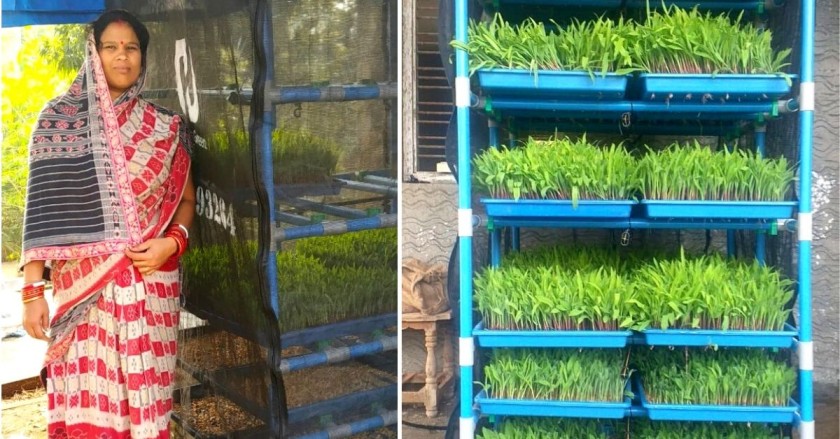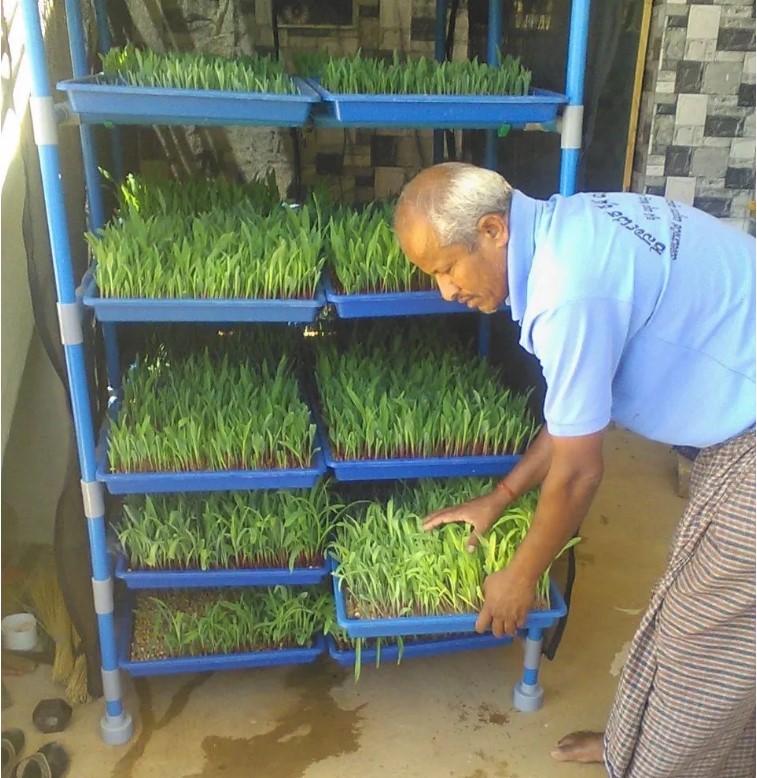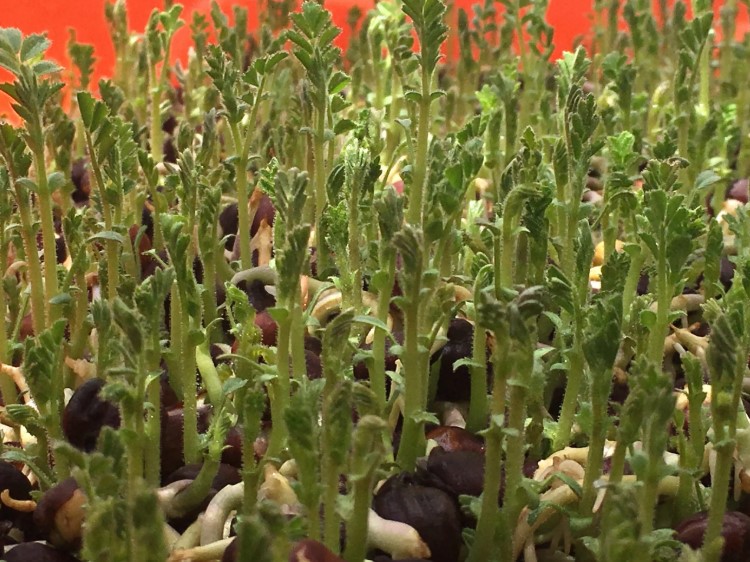Startup’s Low-Cost Hydroponic Innovation Can Solve India’s Acute Fodder Crisis
"Fodder grown in the Kambala machine has been found to increase milk production by around 2 litres per cattle and saved around 15-20 per cent of a farmer's expense on fodder farming."

It was an unusually hot day in Didaga village in Hassan, Karnataka. Vishwa, a local farmer, was out in the sun milking his only buffalo. He stepped out with the milking bucket, expecting the usual less-than-one-bucket yield.
But to his astonishment, the bucket soon became filled up to the brim with milk. He asked his son to fetch another pail and within the next few minutes, it filled up with fresh milk. And another one after that!
Bewildered, Vishwa wondered the reason behind the welcome change. The answer was in front of his eyes — Kambala.
No, not the buffalo race in Karnataka, but a low-cost, sustainable innovation that grows high protein fodder through hydroponics. It was this highly nutritious fodder that helped increase the milk production for Vishwa’s buffalo.
Identifying India’s Overlooked Fodder Crisis
Designed by Bengaluru-based agritech startup Hydrogreens, Kambala is helping solve the acute fodder crisis across India. In a conversation with The Better India, founders Vasanth Kamath and Jeevan M explained how they aspire to empower more marginal farmers through their innovation in the coming days.
While working as a Director of Innovations at a popular retail chain, Vasanth, a Civil Engineer, learnt about the fodder shortage problem in India. “One of our suppliers, a woman farmer from a remote village, was complaining about the fodder shortage in her farm. However, soon I found out that she had managed to avert the problem by herself, using some hack from YouTube.”
“Upon a little in-depth survey, I realised that the problem is relevant to hundreds of farmers across India, and all of them are eager to solve the crisis at minimal expense,” shares Vasanth.
An avid enthusiast of agriculture, Vasanth decided to explore the domain further and contribute to a sustainable solution. He quit his job and set out on a countrywide journey to observe the on-ground situation.

For two years, Vasanth interacted with small and marginal dairy farmers and landholders in Karnataka, Kerala, Andhra Pradesh, Gujarat, Rajasthan and Odisha. He noted the constraints farmers face like altering climate, recurring droughts and the consequent economic turmoil at the grassroots level.
India reportedly suffers nearly 29 per cent deficit in cattle feed, including 11.24 per cent in the availability of fresh green fodder. This, in turn, amounts to a loss in milk production from anything between 20 to 60 per cent than the global average.
“In fact, the government has issued several advisories and came up with projects like fodder banks in the past few years, after the drought scenario intensified. However, the ground-level implementation of these programmes across India will take more time. Meanwhile, the farmers with cattle are struggling to make ends meet and feed their cows and buffaloes,” informs Vasanth.
How A Kambala Works
While brainstorming for a feasible solution, Vasanth thought along the lines of hydroponics, since he had seen many farmers turning towards this method for better fodder production. “But what was lacking was a sachet model that would work for a small, marginal farmer and individual families. That’s why we came up with Kambala,” he informs.
The product can be compared to the structure of a large refrigerator, occupying 3 by 4 feet of ground space and standing 7 feet tall. Inside, racks are installed for growing fodder — 7 racks for 7 days of the week.
Each rack comprises four trays where approximately 700 gms of high-protein seeds of maize are added one day a week. Alternately, seeds of wheat or barley can also be used. Within the next few days, the rack becomes covered with fresh, green fodder ready to be dispensed to the cattle.
The insides of the racks are connected with 14 micro-sprinklers which spray water occasionally according to the need, once the system is connected to a power source. In a day, 25-30 kg of fodder is generated in a Kambala machine, thereby creating enough fodder for at least 4-5 cows in a week.

The water requirement by Kambala is minimal, around 50 litres for 3 days, compared to around 70-100 litres of water required to grow just 1 kg of fodder in traditional field cultivation. The saved water can be redirected to farmlands through drip irrigation and similar methods.
The Kambala is also enveloped with a black net cover from the outside, thereby protecting the growing fodder from excessive heat while allowing ample ventilation. This allowed the system to be installed in areas with high daytime temperatures like interior villages of Rajasthan.
Priced at Rs 30,000, each Kambala generates an electricity bill of less than Rs 70 in a year. The founders have also commissioned a solar-powered version of the machine, which is priced at Rs 45,000 at present. Around 41 units of the solar Kambala is being installed in Anantapur district of Andhra Pradesh, and several other units are already active in Rajasthan, Gujarat and Karnataka. In total, Hydrogreens have installed around 130 Kambala units all over India and benefitted hundreds of farming families.
The Farmers of Fragmented Lands
“The set up was designed by Vasanth,” says Jeevan M, who partnered with the former after knowing about his initiative through a mutual friend. “The problem was so severe, that I decided to quit my corporate job and join Vasanth in this noble pursuit.”

Together, they attended a rigorous course on cattle and fodder growth at National Institute of Animal Nutrition and Physiology before establishing Hydrogreens in January 2019. From understanding the problems of farmers in fragmented lands to coordinating with the rural dairy cooperatives — the duo came a long way before officially registering their company.
“It was quite the culture shock for us — from working in high-end corporate offices to working in heat, cold and rain to collect data for fine-tuning our machine,” says Vasanth. Interestingly, Kambala has been customised in a manner so as to withstand power fluctuations and extreme daytime temperature ranges in rural India. The design was patented by Hydrogreens in 2019.
Restoring a Farmer’s Lost Income
“Vasanth and Jeevan helped me install a Kambala at my home. Now, the entire community of small farmers like us is benefitting from the fodder generated from just one machine,” says Pukraj Jaipal, a farmer and social worker associated with NGO Urmul in Rajasthan. “The machine is very convenient to operate and gives fodder multiple times than what we used to procure from farming. The quality of the fodder is also better, which boosts milk production in cattle,” he adds.
Pukraj has also taken up the responsibility of demonstrating the benefits of Kambala among his fellow villagers, many of whom have decided to install the machine at their home.
“Overall, a Kambala is aimed to restore 15-20 per cent of the farmer’s income from dairy which becomes lost in inputs for traditional fodder production. Fodder grown in Kambala has been found to increase milk production by around 2 litres per cattle,” asserts Jeevan.
Community Fodder Stations
Presently, Hydrogreens is engaged in setting up around 25 community fodder stations in Chitradurga district of Karnataka. These are small commercial units, in each of which a Kambala has been commissioned under the patronage of local agricultural non-profits. Dairy farmers and villagers with cattle can come up to the station every morning and buy the required amount of high-protein fodder for their cattle.
The founders have also received requests of wheatgrass juice and other edible products from Kambala fodder — which is another aspect they wish to explore in these community fodder stations. They are also planning to grow nutrient-rich ragi, millets etc. along with maize, wheat and barley as fresh fodder.

Making India Fodder-secure
The duo zeroed upon the name ‘Kambala’ after the blankets (kambala in Kannada) carried by farmers who spend their days in the field.This blanket serves as a bed for them in the middle of a tiring day, or as a warm wraparound in cold winter mornings.
The ‘Kambala’ remains an unfailing companion of the lonely farmer toiling in his field. Hydrogreens have attempted to incite a similar feeling for a farmer with their innovation.
“The idea is to make farming communities in India fodder secure,” says Vasanth, adding that the product will help foster more farm-based microentrepreneurs in the rural demography of India.
(Edited by Saiqua Sultan)
Like this story? Or have something to share?
Write to us: [email protected]
Connect with us on Facebook and Twitter
If you found our stories insightful, informative, or even just enjoyable, we invite you to consider making a voluntary payment to support the work we do at The Better India. Your contribution helps us continue producing quality content that educates, inspires, and drives positive change.
Choose one of the payment options below for your contribution-
By paying for the stories you value, you directly contribute to sustaining our efforts focused on making a difference in the world. Together, let’s ensure that impactful stories continue to be told and shared, enriching lives and communities alike.
Thank you for your support. Here are some frequently asked questions you might find helpful to know why you are contributing?


This story made me
-
97
-
121
-
89
-
167













